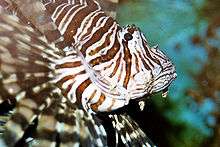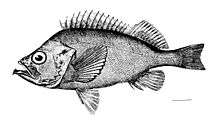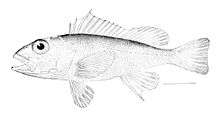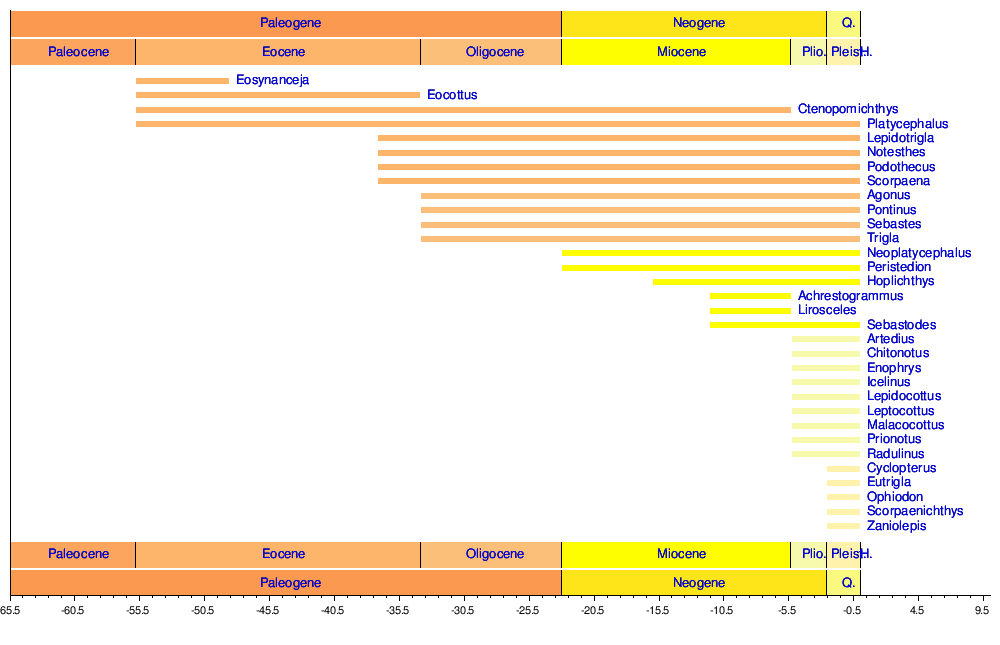Scorpaeniformes
The Scorpaeniformes are a diverse order of ray-finned fish, including the lionfish, but have also been called the Scleroparei. It is one of the five largest orders of bony fishes by number of species, with over 1,320.[1]
| Scorpaeniformes | |
|---|---|
 | |
| Scorpaenidae: Pterois antennata | |
| Scientific classification | |
| Kingdom: | Animalia |
| Phylum: | Chordata |
| Class: | Actinopterygii |
| Superorder: | Acanthopterygii |
| Order: | Scorpaeniformes Greenwood et al., 1966 |
| Type species | |
| Scorpaena porcus | |
| Suborders | |
|
Anoplopomatoidei | |
They are known as "mail-cheeked" fishes due to their distinguishing characteristic, the suborbital stay: a backwards extension of the third circumorbital bone (part of the lateral head/cheek skeleton, below the eye socket) across the cheek to the preoperculum, to which it is connected in most species.[2]
Scorpaeniform fishes are carnivorous, mostly feeding on crustaceans and on smaller fish. Most species live on the sea bottom in relatively shallow waters, although species are known from deep water, from the midwater, and even from fresh water. They typically have spiny heads, and rounded pectoral and caudal fins. Most species are less than 30 cm (12 in) in length, but the full size range of the order varies from the velvetfishes, which can be just 2 cm (0.79 in) long as adults, to the lingcod, which can reach 150 cm (4.9 ft) in length.[2]
One of the suborders of the scorpaeniformes is the scorpaenoidei. This suborder of scorpaeniformes are usually found in the benthic zone, which is the lowest region of any water body such as oceans or lakes. There are two groups of the scorpaenoidei. The sea robins is the first, which are further classified into two families: the sea robins and the armored sea robins. One significant difference between the two families of sea robins is the presence of spine-bearing plate on the armored sea robins which is absent in the sea robins family.
The second group of the scorpaenoidei suborder is the scorpionfishes, which according the Minouri Ishida’s work in 1994 and recent studies, have twelve families. The scorpionfishes are very dynamic in size with the smallest one having a range of 2-3 cm, while the largest have a length of approximately 100cm. [3]
Classification
The division of Scorpaeniformes into families is not settled; accounts range from 26[4][5] to 35 families.[6][7]



Order Scorpaeniformes
- Suborder Anoplopomatoidei
- Anoplopomatidae (sablefish and skilfish)
- Suborder Cottoidei
- Superfamily Cottoidea
- Abyssocottidae (deep-water sculpins)
- Agonidae (poachers)
- Bathylutichthyidae
- Comephoridae (Baikal oilfishes)
- Cottidae
- Cottocomephoridae (Baikal sculpins)
- Ereuniidae (deepwater bullhead sculpins)
- Hemitripteridae (sea ravens)
- Icelidae (scaled sculpins)[lower-alpha 1]
- Psychrolutidae (fathead sculpins)
- Rhamphocottidae (grunt sculpin)
- Superfamily Cyclopteroidea
- Cyclopteridae (lumpsuckers)
- Liparidae (snailfishes)
- Superfamily Cottoidea
- Suborder Hexagrammoidei
- Hexagrammidae (greenlings)
- Suborder Normanichthyiodei
- Normanichthyidae (mote sculpin)
- Suborder Platycephaloidei
- Bembridae (deepwater flatheads)
- Hoplichthyidae (ghost flatheads)
- Parabembridae[lower-alpha 2]
- Peristediidae[8] (armored searobins)
- Platycephalidae (flatheads)
- Suborder Scorpaenoidei
- Apistidae[lower-alpha 3] (wasp scorpionfishes)
- Aploactinidae (velvetfishes)
- Caracanthidae (orbicular velvetfishes)
- Congiopodidae (horsefishes and pigfishes)
- Eschmeyeridae
- Gnathanacanthidae (red velvetfish)
- Neosebastidae[lower-alpha 3] (gurnard scorpionfishes)
- Pataecidae (Australian prowfishes)
- Perryenidae[9] (Whitenose pigfish)
- Plectrogenidae[lower-alpha 3]
- Scorpaenidae (scorpionfishes)
- Sebastidae (sea perches)[lower-alpha 3]
- Setarchidae[lower-alpha 3] (deep-sea bristly scorpionfishes)
- Synanceiidae (including the stonefishes)
- Tetrarogidae (waspfishes)[lower-alpha 3]
- Triglidae (searobins)
Timeline of genera

See also
Notes
- Icelidae is described as a separate family by some sources , containing only the genus Icelus. However, this genus which is considered to be a member of Cottidae by most other sources
- Parabembridae is included in Bembridae in ITIS and Nelson, but split in FishBase and Eschmeyer.
- Apistidae, Neosebastidae, Plectrogenidae, Sebastidae, and Setarchidae are included in Scorpaenidae in ITIS and Nelson, but split in FishBase and Eschmeyer.
References
- Umich.edu
- Eschmeyer, William N. (1998). Paxton, J.R.; Eschmeyer, W.N. (eds.). Encyclopedia of Fishes. San Diego: Academic Press. p. 175. ISBN 0-12-547665-5.
- "Scorpaeniformes II (Scorpionfishes and Relatives) | Encyclopedia.com". www.encyclopedia.com. Retrieved 11 April 2020.
- Joseph S. Nelson. Fishes of the World. John Wiley & Sons. ISBN 0-471-54713-1.
- "Scorpaeniformes". Integrated Taxonomic Information System. Retrieved 31 March 2006.
- William N. Eschmeyer; Carl J. Ferraris; Mysi D. Hoang; Douglas J. Long (1998). Catalog of Fishes. California Academy of Sciences. ISBN 0-940228-47-5.
- Froese, Rainer, and Daniel Pauly, eds. (2006). "Scorpaeniformes" in FishBase. February 2006 version.
- WoRMS (1883). Bailly N (ed.). "Peristediidae Jordan & Gilbert, 1883". FishBase. World Register of Marine Species. Retrieved 24 April 2015.
- Honma, Y., Imamura, H. & Kawai, T. (2013): Anatomical description of the genus Perryena, and proposal to erect a new family for it based on its phylogenetic relationships with related taxa (Scorpaeniformes). Ichthyological Research, DOI 10-1007/s10228-012-0321-z
- Sepkoski, Jack (2002). "A compendium of fossil marine animal genera". Bulletins of American Paleontology. 364: 560. Retrieved 17 May 2011.